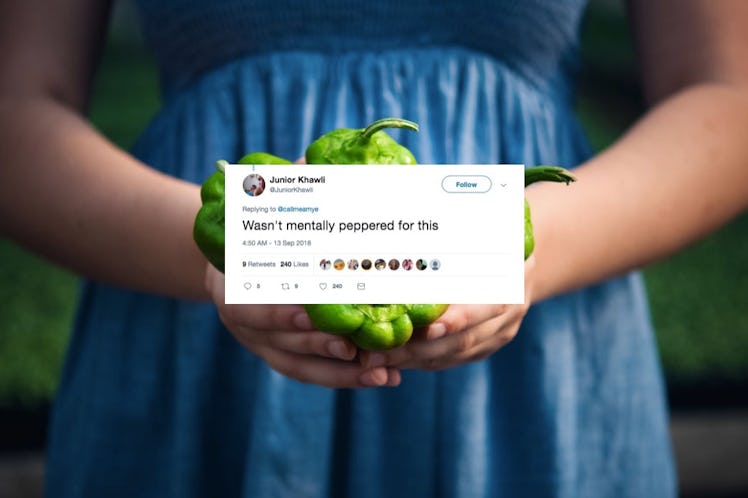
People Are Just Now Realizing The Truth About Bell Peppers & Twitter Is Shook
There's something new making a splash on the internet, and, shockingly, it's vegetables. Most people I know have a preference in terms of what variety of bell pepper is the most delicious; I'm on team yellow, personally. Green peppers are pretty bitter, reds are too sweet, and the orange ones don't seem to have a whole lot of flavor, IMO, leaving yellow as the sole contender for the perfect pepper. But Twitter is now in an uproar with tweets about green, orange, and red peppers, though the debate isn't about which of them is best. Rather, people can't seem to figure out whether these different colored peppers are all versions of the same vegetable, or if they're all actually completely separate foods.
It looks like there's one tweet that started it all, and while it wasn't exactly scientifically accurate, it definitely got people talking about the colorful veggies. Style and lifestyle blogger Amy Eade (@callmeamye on Twitter) seemed to have been told that each pepper color represents the same variety, but at varying stages of ripeness. So, to her understanding, green peppers would eventually turn into yellow ones, and so on until they reached bright red, peak ripeness.
OK, I have lots of questions. First of all, does that mean grocery stores and farmers' markets across the country are selling the same exact veggies at four different ripeness stages? Also, do they have to move each pepper to a different section every couple of days once it turns into an entirely different color? I need answers, people.
But Twitter didn't exactly provide me with any legit answers; instead, they just left me feeling even more confused.
While most people were stunned by this apparent revelation, James Wong, an ethnobotanist and author of the book How To Eat Better, stepped in to clear things up a little bit. Apparently, according to Wong, green peppers are unripe versions of the other colored vegetables, but the other colors aren't all the same. In other (entirely mine, definitely non-scientific) words, green peppers are teenagers, and all of the others are already adults.
If you're someone on a budget like me, you're probably wondering how grocery stores can charge more for the red and orange peppers when the cheaper green ones are just the unripe versions. Sounds like a rip-off, right? Well, according to The Kitchn, “yellow, orange, and red peppers use more resources since they’re harvested later, making them more expensive.” This might also explain why green peppers can sometimes taste more bitter than their colorful counterparts. In fact, they can also cause some people to experience stomach pain, since they contain a higher level of something called solanine — a potentially poisonous substance that, according to millennial fitness brand Fitness Republic, can be found in very small quantities in other colored peppers.
To say the least, this is a confusing concept, and my first thought in terms of how to get to the bottom of it all was to buy green peppers and then wait a few days to see if they ripen into a sweet red or yellow pepper. Genius, right? Sadly, though, apparently it doesn't work that way. According to The Kitchn, the ripening needs to take place primarily on the vine. Boooo.
As for the ethnobotanist-turned-pepper-myth-debunker, Wong, he also took this opportunity to dispel another myth that was making the rounds on the internet: the idea that the bumps on the bottoms of peppers represent the veggies' "genders."
All debates aside, I think my personal favorite tweet in this viral thread is this photo of a pepper that seems to have been picked mid-transition between green and orange, hilariously titled "ombre pepper."
But the revelations aren't over yet, folks. I also have other world-changing news, I'm afraid: Peppers aren't technically vegetables at all, but are actually classified as fruits. Along with avocados, olives, zucchini, and cucumbers, bell peppers are fruits because they originate from plant parts that develop from flowers and contain seeds, according to Healthline. So that avo, zucchini, and cucumber salad you had for lunch? Scientifically speaking, it's a fruit salad.